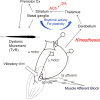Pathogenesis of dystonia: is it of cerebellar or basal ganglia origin?
- PMID: 29089396
- PMCID: PMC5909758
- DOI: 10.1136/jnnp-2017-316250
Pathogenesis of dystonia: is it of cerebellar or basal ganglia origin?
Abstract
Dystonia is a disorder of motor programmes controlling semiautomatic movements or postures, with clinical features such as sensory trick, which suggests sensorimotor mismatch as the basis. Dystonia was originally classified as a basal ganglia disease. It is now regarded as a 'network' disorder including the cerebellum, but the exact pathogenesis being unknown. Rare autopsy studies have found pathology both in the striatum and the cerebellum, and functional disorganisation was reported in the somatosensory cortex in patients. Recent animal studies showed physiologically tight disynaptic connections between the cerebellum and the striatum. We review clinical evidence in light of this new functional interaction between the cerebellum and basal ganglia, and put forward a hypothesis that dystonia is a basal ganglia disorder that can be induced by aberrant afferent inputs from the cerebellum.
Keywords: cerebellar disease; dystonia; functional imaging; movement disorders; neurophysiology.
© Article author(s) (or their employer(s) unless otherwise stated in the text of the article) 2018. All rights reserved. No commercial use is permitted unless otherwise expressly granted.
Conflict of interest statement
Competing interests: None declared.
Figures



References
-
- Destarac J. Torticolis spasmodique et spasmes functionnels. Rev Neurol (Paris) 1901;9:591–7.
Publication types
MeSH terms
LinkOut - more resources
Full Text Sources
Other Literature Sources
Medical
